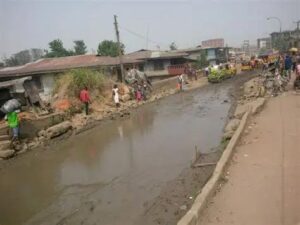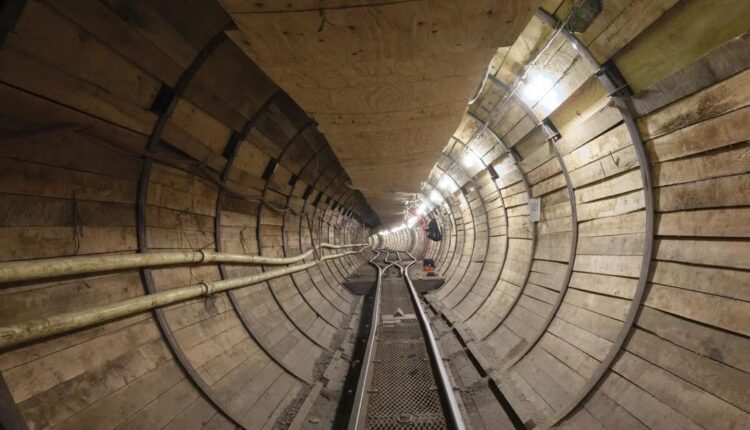The year 2020 marked a turning point for urban sanitation in Ghana’s Ashanti Region. The Sokoban Trunk Sewer Project emerged not merely as a local infrastructure improvement, but as a transformative model that would reshape wastewater management across the nation.
At the heart of this revolution stood Amoh Tontoh, a Senior Water and Wastewater Engineer whose innovative approach solved immediate problems while creating a replicable blueprint for similar communities.

Extreme Deterioration in trunk sewer system exposed reinforcement, sinkholes etc
Prior to this intervention, Sokoban’s southern districts grappled with a sanitation crisis that mirrored challenges throughout urban Africa. Aging septic systems overflowed regularly, contaminating groundwater and flooding streets with raw sewage.

Sokoban’s southern districts’ sanitation crisis leading to contamination of nearby streams and groundwater
Waterborne diseases ran rampant, particularly during rainy seasons. The situation stifled economic growth as businesses hesitated to invest in areas plagued by chronic sanitation failures. Traditional solutions had proven inadequate, demanding a fresh engineering perspective.
The solution developed under Amoh Tontoh’s leadership combined technical excellence with practical adaptability. A 7.5-kilometer gravity-based trunk sewer system eliminated dependence on expensive pumping stations while accommodating future expansion. The design team led by Amoh Tontoh navigated complex urban terrain using trenchless technology to minimize disruption to roads, wetlands, and existing infrastructure. Strategic routing decisions reduced construction costs by 22% compared to conventional approaches. The system’s crowning innovation was its dual-function design, serving both as arterial infrastructure and collection network—a first for mid-sized Ghanaian communities.
The project’s success resonated far beyond Sokoban’s boundaries. Ghana’s Environmental Protection Agency (EPA) documented measurable improvements that caught the attention of urban planners nationwide. Within three years, core elements of the Sokoban design had been adapted for twenty additional projects across four regions. The Pekyi Township implementation reduced costs by 18% through optimized trenchless methods. Bekwai’s expansion project demonstrated the scalability of the dual-function concept for larger populations. Kumasi’s peri-urban initiative proved the model’s adaptability for satellite communities.

Redesigned and engineered Sokoban trunk sewer system
This widespread replication created ripple effects throughout Ghana’s engineering community. The EPA incorporated Sokoban-inspired standards into national guidelines for mid-sized city sanitation projects. Engineering curricula at Kwame Nkrumah University of Science and Technology began featuring the project as a case study in cost-effective urban infrastructure. Municipalities reported cumulative savings exceeding GHS 13 million annually from reduced maintenance costs across replicated systems.
The tangible impacts on communities have been profound. Sokoban itself saw an 85% reduction in sewage-related illnesses within two years of system activation. Property values in connected neighborhoods surged by 40%, stimulating local economic activity. Perhaps most significantly, groundwater quality tests showed measurable improvements, addressing a chronic public health threat. Similar benefits emerged in replication sites, with the Bekwai project alone connecting 12,000 previously underserved residents to proper sewer system.
As Senior Project Engineer, Amoh Tontoh’s contribution extended beyond technical design to establishing new best practices for the field. The project demonstrated how rigorous hydraulic modeling could be balanced with community needs and environmental protection. It proved that gravity systems could outperform pumped alternatives in both cost and reliability for certain urban configurations. Most importantly, it established a replicable framework that continues to guide sanitation investments across Ghana.
The Sokoban model’s relevance grows as African urbanization accelerates. Its success in communities of 50,000-100,000 residents offers a scalable solution for fast-growing secondary cities throughout the continent. The project’s emphasis on simple, maintainable technology makes it particularly valuable for municipalities with limited technical workforces. Environmental safeguards built into the design align with global climate adaptation priorities for water infrastructure.
After its completion, the Sokoban Trunk Sewer Project stands as more than infrastructure – it represents a paradigm shift in how Ghana approaches urban sanitation and sewer management. By demonstrating that innovative engineering can deliver both immediate solutions and long-term frameworks for growth, the project has become a cornerstone of the nation’s SDG 6 implementation strategy. As replication continues in new communities, its legacy as a catalyst for public health and economic development keeps expanding, proving that one well-conceived project can indeed transform an entire nation’s approach to urban challenges.
The story of Sokoban’s sanitation transformation continues to inspire engineers and policymakers alike. It serves as a powerful reminder that sustainable urban development requires not just technical solutions, but visionary leadership that can turn local successes into national progress -a lesson that Amoh Tontoh’s work has etched indelibly into Ghana’s development narrative.
Report by Yaw Ampofo Junior


Comments are closed.